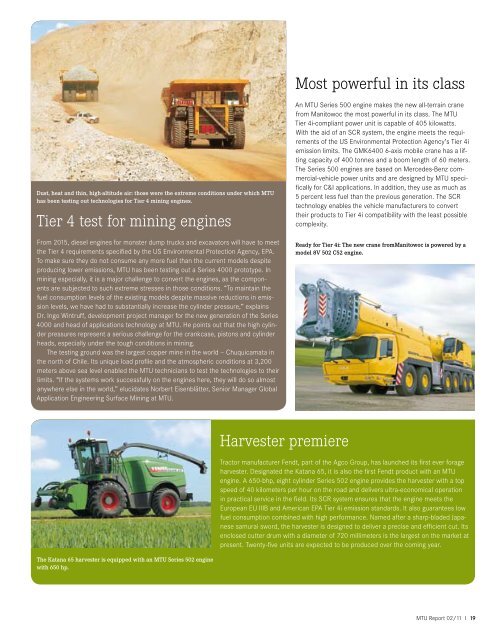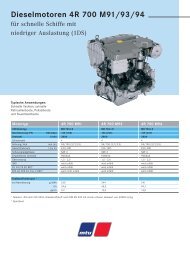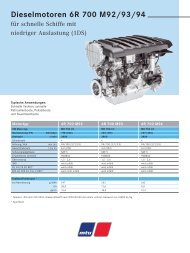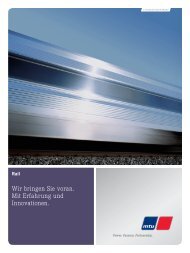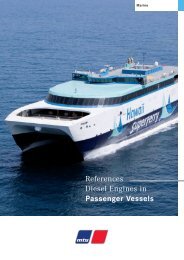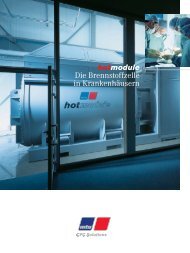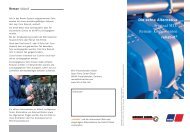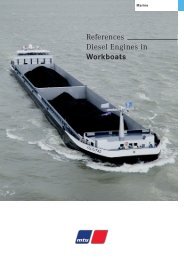Create successful ePaper yourself
Turn your PDF publications into a flip-book with our unique Google optimized e-Paper software.
Dust, heat and thin, high-altitude air: those were the extreme conditions under which <strong>MTU</strong><br />
has been testing out technologies for Tier 4 mining engines.<br />
Tier 4 test for mining engines<br />
From 2015, diesel engines for monster dump trucks and excavators will have to meet<br />
the Tier 4 requirements specified by the US Environmental Protection Agency, EPA.<br />
To make sure they do not consume any more fuel than the current models despite<br />
producing lower emissions, <strong>MTU</strong> has been testing out a Series 4000 prototype. In<br />
mining especially, it is a major challenge to convert the engines, as the components<br />
are subjected to such extreme stresses in those conditions. “To maintain the<br />
fuel consumption levels <strong>of</strong> the existing models despite massive reductions in emission<br />
levels, we have had to substantially increase the cylinder pressure,” explains<br />
Dr. Ingo Wintruff, development project manager for the new generation <strong>of</strong> the Series<br />
4000 and head <strong>of</strong> applications technology at <strong>MTU</strong>. He points out that the high cylinder<br />
pressures represent a serious challenge for the crankcase, pistons and cylinder<br />
heads, especially under the tough conditions in mining.<br />
The testing ground was the largest copper mine in the world – Chuquicamata in<br />
the north <strong>of</strong> Chile. Its unique load pr<strong>of</strong>ile and the atmospheric conditions at 3,200<br />
meters above sea level enabled the <strong>MTU</strong> technicians to test the technologies to their<br />
limits. “If the systems work successfully on the engines here, they will do so almost<br />
anywhere else in the world,” elucidates Norbert Eisenblätter, Senior Manager Global<br />
Application Engineering Surface Mining at <strong>MTU</strong>.<br />
The Katana 65 harvester is equipped with an <strong>MTU</strong> Series 502 engine<br />
with 650 hp.<br />
Harvester premiere<br />
Most powerful in its class<br />
An <strong>MTU</strong> Series 500 engine makes the new all-terrain crane<br />
from Manitowoc the most powerful in its class. The <strong>MTU</strong><br />
Tier 4i-compliant power unit is capable <strong>of</strong> 405 kilowatts.<br />
With the aid <strong>of</strong> an SCR system, the engine meets the requirements<br />
<strong>of</strong> the US Environmental Protection Agency’s Tier 4i<br />
emission limits. The GMK6400 6-axis mobile crane has a lifting<br />
capacity <strong>of</strong> 400 tonnes and a boom length <strong>of</strong> 60 meters.<br />
The Series 500 engines are based on Mercedes-Benz commercial-vehicle<br />
power units and are designed by <strong>MTU</strong> specifically<br />
for C&I applications. In addition, they use as much as<br />
5 percent less fuel than the previous generation. The SCR<br />
technology enables the vehicle manufacturers to convert<br />
their products to Tier 4i compatibility with the least possible<br />
complexity.<br />
Ready for Tier 4i: The new crane fromManitowoc is powered by a<br />
model 8V 502 C52 engine.<br />
Tractor manufacturer Fendt, part <strong>of</strong> the Agco Group, has launched its first ever forage<br />
harvester. Designated the Katana 65, it is also the first Fendt product with an <strong>MTU</strong><br />
engine. A 650-bhp, eight cylinder Series 502 engine provides the harvester with a top<br />
speed <strong>of</strong> 40 kilometers per hour on the road and delivers ultra-economical operation<br />
in practical service in the field. Its SCR system ensures that the engine meets the<br />
European EU IIIB and American EPA Tier 4i emission standards. It also guarantees low<br />
fuel consumption combined with high performance. Named after a sharp-bladed Japanese<br />
samurai sword, the harvester is designed to deliver a precise and efficient cut. Its<br />
enclosed cutter drum with a diameter <strong>of</strong> 720 millimeters is the largest on the market at<br />
present. Twenty-five units are expected to be produced over the coming year.<br />
<strong>MTU</strong> Report 02/11 I 19


